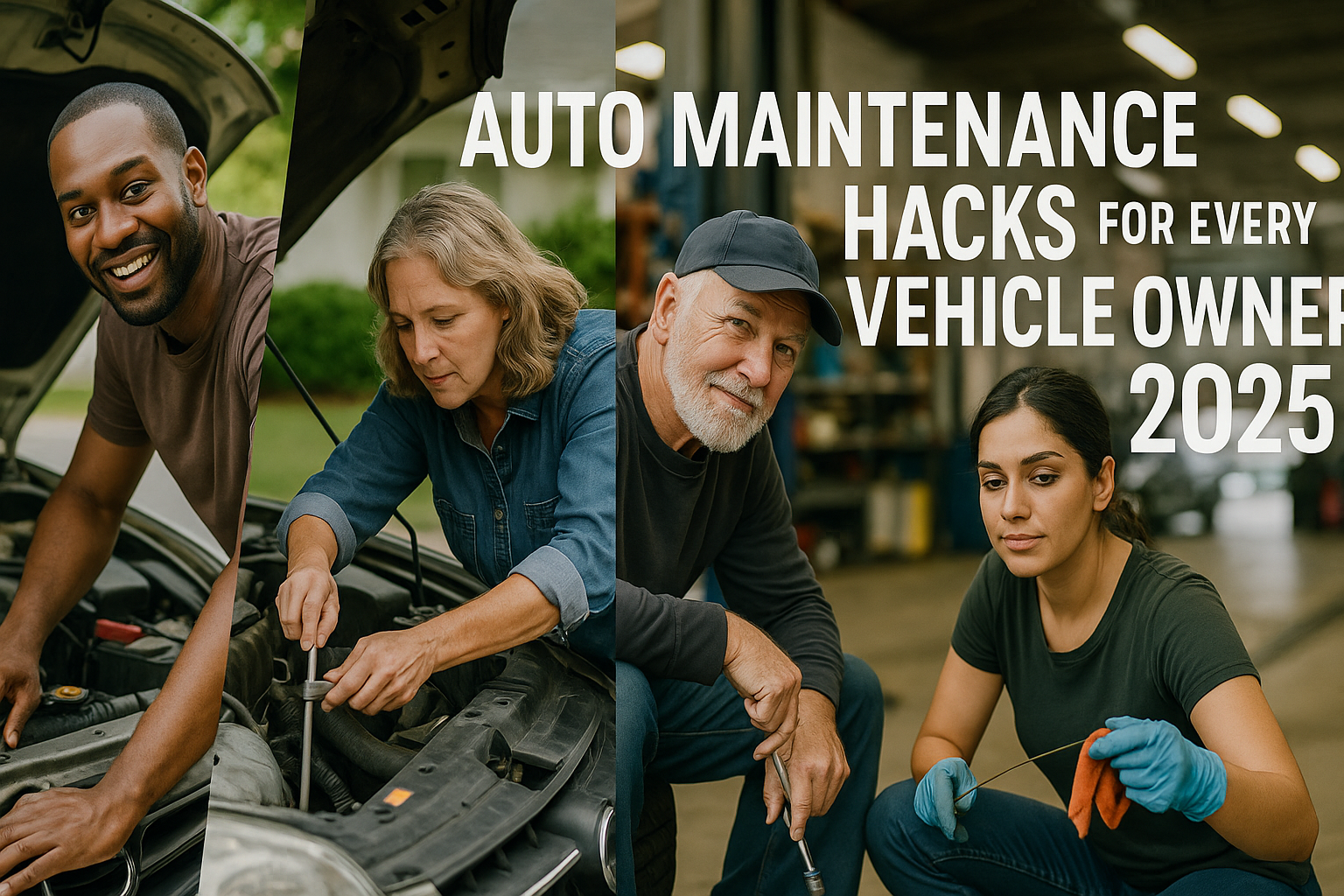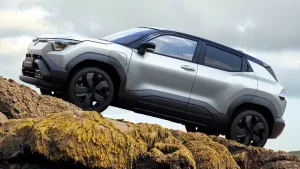Autos & Vehicles
Decoding the 2025 Toyota Crown Signia: A Sneak Peek

Introduction
In the realm of automotive innovation, few unveilings garner as much anticipation and excitement as the introduction of a new model from Toyota. The latest buzz surrounds the 2025 Toyota Crown Signia, a crossover SUV poised to make its mark in the competitive mid-size segment. As enthusiasts eagerly await its arrival, let’s delve into what sets the Crown Signia apart and what enthusiasts can expect from this upcoming release.
Unveiling the Crown Signia: Toyota Crown Signia

Image by: carbuzz.com
The 2025 Toyota Crown Signia emerges as a testament to Toyota’s commitment to pushing the boundaries of automotive excellence. Positioned as a crossover sibling to the esteemed Crown sedan, the Signia promises to blend luxury and performance in a package that’s sure to captivate drivers and critics alike. With the discontinuation of the Venza, the Signia steps up to fill the void, offering a compelling alternative for buyers seeking both style and substance in their mid-size SUV.
A Glimpse Inside: Interior and Design
Step inside the Crown Signia, and you’re greeted by a cabin that exudes sophistication and refinement. Toyota has spared no expense in ensuring that every aspect of the interior exudes luxury, from the premium materials to the ergonomic design. With ample space for passengers and a versatile cargo area, the Signia strikes the perfect balance between comfort and practicality. Whether it’s a daily commute or a weekend getaway, the Signia promises to elevate every journey with its impeccable craftsmanship and attention to detail.
Under the Hood: Toyota Crown Signia
At the heart of the Crown Signia lies a hybrid powertrain that exemplifies Toyota’s commitment to sustainability and efficiency. Powered by a combination of a 2.5-liter naturally aspirated four-cylinder gasoline engine and three electric motors. The Signia delivers a potent blend of power and responsiveness. With standard all-wheel drive capability, it’s ready to tackle any road or weather condition with confidence and composure. While precise performance figures are yet to be disclosed. Early indications suggest that the Signia will offer a driving experience that’s both exhilarating and environmentally conscious.
Tech-Savvy and Connected: Infotainment and Connectivity
In an era defined by digital connectivity, the Crown Signia raises the bar with its advanced technology features. Anchored by a sleek and intuitive touchscreen interface, it offers seamless integration with wireless Apple CarPlay and Android Auto. Keeping drivers connected and entertained on the go. From navigation assistance to hands-free communication. The Signia ensures that drivers remain focused on the road ahead while staying connected to the world around them. With over-the-air updates and voice-activated controls, it embodies the future of automotive connectivity, setting new standards for convenience and innovation.
Safety First: Driver-Assistance Features of Toyota Crown Signia
Safety is paramount in the design of the Crown Signia, with a comprehensive suite of driver-assistance features as standard. Automatic emergency braking, adaptive cruise control, and blind-spot monitoring are just a few of the advanced technologies. Aimed at enhancing driver confidence and mitigating risks on the road. With its proactive safety measures and advanced collision avoidance systems. The Signia offers peace of mind to drivers and passengers alike, making every journey a secure and enjoyable experience.

Image by: carbuzz.com
Anticipation Builds: Pricing and Expectations
As anticipation builds for the release of the 2025 Toyota Crown Signia, pricing estimates suggest that it will command a premium over its predecessors. While exact pricing details have yet to be announced, enthusiasts can expect the Signia to offer exceptional value for money, given its blend of luxury, performance, and innovation. With its arrival set to shake up the mid-size SUV segment. The Signia promises to redefine what drivers can expect from a crossover vehicle—setting new benchmarks for excellence and versatility in the years to come.
Conclusion
In conclusion, the 2025 Toyota Crown Signia represents a bold step forward for the brand. Redefining the boundaries of luxury and performance in the mid-size SUV segment. With its blend of style, technology, and safety, it sets a new standard for excellence. Reaffirming Toyota’s position as a leader in automotive innovation. As anticipation mounts for its release, the Crown Signia promises to captivate drivers with its unparalleled combination of sophistication and versatility. Setting a new benchmark for crossover vehicles in the years to come.
Autos & Vehicles
Mechanic Horror Stories and How to Avoid Becoming One

Introduction
Car trouble can be stressful, but you know what’s worse than your car breaking down? Being the subject of a mechanic horror story.
Whether it’s:
- A simple oil change gone wrong,
- A repair shop charging thousands for unnecessary work,
- Or a DIY job that leads to an engine fire
Every mechanic has their war stories, and every car owner dreads becoming one. In this in-depth guide, we’ll walk you through true-to-life mechanic horror stories, what went wrong, and how you can avoid becoming the next cautionary tale. Because when it comes to auto repair, a little knowledge can save you a lot of money and a whole lot of headaches.
Chapter 1: The $6,000 Brake Job That Should Have Cost $300
The Horror
A woman brings her sedan in for a brake inspection. She hears a squeaking noise. The shop says she needs:
- New brake pads
- Rotors
- Calipers
- Brake lines
- Master cylinder
Total bill: $6,148.
She agrees, trusting their “expertise.” Later, another mechanic discovers she only needed brake pads and a rotor resurface.
What Went Wrong:
- She didn’t get a second opinion.
- She didn’t ask to see the damaged parts.
- The shop preyed on fear.
How to Avoid It:
- Always get a second opinion for jobs over $500.
- Ask the mechanic to show you worn or broken parts.
- Look up average repair costs online before agreeing.
- Choose ASE-certified or well-reviewed shops.
Chapter 2: The DIY Timing Belt Disaster
The Horror
A car owner watches a YouTube video and decides to change the timing belt on their own to “save money.” They skip a step not aligning timing marks correctly. When they crank the engine, valves hit pistons. Catastrophic engine damage.
Estimated rebuild: $3,800.
What Went Wrong:
- Lack of experience
- No torque wrench or timing tools
- Rushed the process
How to Avoid It:
- Know your limits some jobs are not DIY-friendly.
- Timing belts and engine internals should be left to pros unless you’re experienced.
- If you must DIY, follow the factory service manual, not just YouTube.
- Rent or buy the proper specialty tools.
Chapter 3: The Oil Change That Ruined an Engine
The Horror
A quick-lube shop changes the oil but forgets to install the oil drain plug correctly. Oil leaks out during the drive home. The engine seizes. Total loss. They later admit it was a new employee who forgot to torque the bolt.
Repair Cost: A new engine = $5,500
The company settled, but it took months.
What Went Wrong:
- Rushed service
- No double-check
- Low-skill labor
How to Avoid It:
- Avoid bottom-of-the-barrel shops offering $19 oil changes.
- Go to a reputable shop where mechanics are trained.
- After an oil change, check for leaks or low oil levels the next day.
- Listen for unusual engine noises after any service.
Chapter 4: The Mystery Engine Light That Drained a Wallet
The Horror:
A man notices his check engine light. He visits three shops. One says O2 sensor. Another says catalytic converter. The third says the transmission is slipping. He agrees to a $2,000 repair. The light returns days later.
Turns out? It was a loose gas cap the entire time.
What Went Wrong:
- No proper diagnostic process
- Mechanics relying on code readers, not diagnosis
- Fear-based upselling
How to Avoid It:
- Don’t rely on free code scans at parts stores.
- Ask for diagnostic verification before approving repairs.
- Ask: “Can you prove this part is bad before replacing it?”
- Tighten your gas cap first—you’d be amazed how often that’s the issue.
Chapter 5: The Battery Switch Scam
The Horror
A young driver is told their car’s battery is dead. The shop installs a new one for $250. Later, a friend who’s a mechanic tests the “old” battery it’s fine. They were upsold a perfectly working part.
What Went Wrong:
- Blind trust in mechanic
- No test report shown
- Paid before asking questions
How to Avoid It:
- Always ask to see the battery test results.
- Learn to test a battery yourself using a voltmeter ($15 tool).
- If a shop can’t explain why a part failed, don’t agree to replacement.
Chapter 6: The Fuel Injector Flush Fiasco
The Horror
A dealership insists the customer needs a fuel injector cleaning for $300. The car runs fine, no symptoms. They agree. Later, the check engine light comes on. Injectors were improperly flushed now clogged. The vehicle needs new injectors.
Repair: $1,200.
What Went Wrong:
- Unnecessary service
- Improper equipment used
- No warning signs to begin with
How to Avoid It:
- Avoid upsells during regular maintenance unless there’s a clear reason.
- Injector flushes are often unnecessary for newer cars using quality fuel.
- Ask: “Can I see proof my injectors are dirty or misfiring?”
- Don’t assume dealerships always do the right thing.
Chapter 7: The Wrong Oil Type Wrecked the Engine
The Horror
An SUV owner goes to a chain shop. They install 10W-30 oil instead of the required 0W-20. Oil doesn’t flow well in the engine’s tight tolerances. Sludge builds up. Engine failure at 40,000 miles. Warranty denied due to incorrect maintenance.
Cost: Full engine replacement not covered = $7,000
What Went Wrong:
- Wrong oil for modern engine
- No verification by customer
- Chain shop shortcuts
How to Avoid It:
- Always verify the correct oil type and viscosity for your engine.
- Request a printout of the oil used.
- Use shops that specialize in your car make, especially for turbo or hybrid engines.
Chapter 8: The Towed Car That Was “Lost”
The Horror
After a breakdown, a woman has her car towed to a local shop. Three days later, they say they “don’t have it.” Turns out the tow driver dropped it at the wrong shop. She spends hours tracking it down herself.
What Went Wrong:
- Poor communication
- Shop failed to verify
- Tow company error
How to Avoid It:
- Always confirm shop address and name with tow driver.
- Ask for a drop-off confirmation or photo.
- Call the shop to alert them before and after the tow.
Chapter 9: The Dangerous Used Tire Swap
The Horror
A driver gets four “good used tires” installed at a small shop for cheap. On the highway, one blows out. The tires were 10 years old way past expiration. Car crashes. Driver injured.
What Went Wrong:
- No tire age check
- Trust in shady vendor
- Poor tire quality
How to Avoid It:
- Always check the DOT date code on tires.
- Don’t buy used tires unless you can verify age and condition.
- Tire rubber degrades over time—age matters more than tread.
Chapter 10: The Ghost Mechanic Money Gone, No Repair
The Horror
A mobile mechanic offers a “discount” to fix a head gasket. He asks for a deposit upfront: $700. He never returns. Calls go unanswered. No contract, no address.
What Went Wrong:
- No documentation
- Paid before service
- No background check
How to Avoid It:
- Never pay in full upfront for mobile repairs.
- Ask for references, certifications, or ID.
- Use platforms like Yelp, Google, or Thumbtack with real reviews.
- Get everything in writing.
Chapter 11: What Mechanics Wish You Knew to Avoid These Nightmares
1. Ask Questions
A good mechanic welcomes your questions. Ask:
- Why does this need replacing?
- Can I see the damaged part?
- What happens if I wait?
2. Get It in Writing
Estimates, warranties, and work orders should all be written—no exceptions.
3. Know the Basics
You don’t have to be a pro, but know:
- How to check fluids
- How to recognize warning signs
- What your car’s lights mean
4. Check Reviews & Certifications
Look for:
- ASE-certification
- BBB ratings
- Google/Yelp reviews (with details)
5. Build a Relationship
Find a mechanic you trust and stick with them. Loyalty often means better service, honesty, and personalized care.
Conclusion: Don’t Be the Next Horror Story
Every horror story you’ve read here has one thing in common:
A lack of information, communication, or preparation.
You can avoid being the next cautionary tale by:
- Doing your homework
- Asking questions
- Saying “no” when something feels off
- Choosing professionals over shortcuts
- Knowing the basic signs of car trouble
Cars may break down but how you handle the repair process makes all the difference. Mechanics want to help but like in every profession, not all are created equal. Be proactive, not reactive and you’ll stay far away from the horror stories next time you’re in the shop.
Autos & Vehicles
Auto Maintenance Hacks for Every Vehicle Owner 2025

Introduction
Keeping your car running smoothly doesn’t have to cost a fortune. With simple auto maintenance hacks, you can cut down on repair bills and extend the life of your vehicle. In 2025, new tools and methods make it easier than ever to do quick checks at home. Whether you drive a compact car or a heavy-duty truck, these vehicle care tips will help you stay safe on the road. Ready to learn how small tweaks can make a big difference? Let’s dive into the world of DIY car maintenance and take control of your ride.
What Is Auto Maintenance?

Image by: Yandex.com
Auto maintenance means regular checks and fixes to keep your vehicle’s manufacturer in top shape. It covers tasks like oil changes, tire inspections, and fluid top-ups. By staying on schedule, you avoid costly breakdowns. Simple steps, such as checking tire pressure or replacing wiper blades, can prevent bigger problems. Think of maintenance as health care for your car. Just as you see a doctor for routine checkups, your vehicle needs attention too. With these hacks, you’ll spot issues early and fix them before they grow.
Why Auto Maintenance Matters

Image by: Yandex.com
Ignoring basic maintenance harms your car’s performance and safety. Low oil or worn brakes can lead to engine damage or accidents. Regular upkeep also improves fuel efficiency. A well-maintained engine uses less gas and saves you money at the pump. Plus, keeping good records can boost your car’s resale value. Buyers pay more for vehicles with a full service history. By mastering simple auto maintenance hacks, you protect your investment and enjoy a smoother drive every day.
Top Auto Maintenance Hacks for Every Vehicle Owner 2025

Image by: Yandex.com
1. DIY Oil Change Hacks
Changing your oil doesn’t need a garage visit. First, warm the engine for a few minutes. Warm oil flows out faster, taking debris with it. Next, use a quality oil drain pan with spout for a clean pour. When picking oil, check your manual for the right grade. Synthetic blends may cost more but last longer. Replace the oil filter too—old filters trap dirt and reduce flow. Tighten the drain plug to spec but avoid over-torquing. Finally, top up with fresh engine oil and run the engine to check levels. With practice, you can finish in under 30 minutes.
2. Tire Care Hacks
Proper tire care boosts safety and fuel economy. Invest in a digital tire pressure gauge for accurate readings. Check air pressure when tires are cold—ideally in the morning. Under-inflated tires wear unevenly and use more gas. Rotate your tires every 6,000 miles to extend tread wear life. You can mark them with chalk for easy reference. Inspect tread depth with a penny: insert Lincoln’s head upside down; if you see his hair, it’s time to replace. For quick patch-ups, keep a tubeless tire repair kit in your trunk. These simple tire pressure check steps can save you from flats and blowouts.
3. Brake and Fluid Hacks
Brakes wear out over time and need attention. Listen for squeaks or grinding sounds—these signal worn pads. You can swap pads yourself with basic hand tools. Before you start, jack up the car and secure it with stands. Remove the wheel, slide out old brake pads, and fit new ones. Brake transmission fluid should be clear; dark fluid means moisture and contamination. A clear-tube bleed kit makes fluid levels exchange easy—just attach, pump, and refill. Clean the calipers with brake cleaner spray. After reassembly, press the pedal several times to seat new parts. Safe braking starts with simple vehicle care tips.
4. Engine Tune-Up Schedule Hacks
A smooth engine delivers power and efficiency. Spark plugs spark combustion; when worn, they cause misfires. Replace plugs every 30,000 miles or as your manual suggests. Gap them to spec with a feeler gauge for best performance. Air filters block dust; swap or clean them every 12,000 miles. Clogged filters choke your engine and lower mileage. Fuel injectors benefit from an in-tank cleaner added every oil change. It removes varnish and deposits for better spray patterns. Check belts and hoses for cracks or leaks. A cracked belt can strand you; replace it at the first sign of wear. Follow this engine tune-up schedule to keep your motor happy.
5. Seasonal Maintenance Hacks
Every season brings unique car needs. In winter, swap to cold-weather oil and check your battery’s health. Ice and salt corrode metal—spray undercarriage with rust inhibitor. In spring, clean out sand and salt buildup under fenders. Summer heat calls for coolant checks; top up with a 50/50 antifreeze mix to prevent boil-overs. Inspect your AC system by checking airflow and listening for strange noises. In fall, clear leaves from vents and gutters to avoid clogs. Seasonal vehicle care tips protect your car against weather damage and extend its lifespan.
6. Interior and Exterior Care Hacks
A clean car looks newer and holds value. For the exterior, use a foam cannon and pressure washer to remove grime gently. Dry with a microfiber towel to avoid swirl marks. Apply a spray wax every few months for protection. On windows, use a glass-only cleaner and a lint-free cloth for streak-free shine. Inside, vacuum seats and mats weekly. For leather surfaces, choose a pH-balanced conditioner to prevent cracks. Use a soft brush to clean air vents and hard-to-reach spots. Place a baking soda sachet under seats to absorb odors. Regular cleaning is a key part of DIY car preventive maintenance.
Comparative Table: Maintenance Schedule at a Glance
| Service Task | DIY Interval | Pro Check Interval |
|---|---|---|
| Oil & Filter Change | Every 5,000 mi | Every 12,000 mi |
| Tire Rotation | Every 6,000 mi | Every 12,000 mi |
| Brake Pad Inspection | Every 10,000 mi | Every 20,000 mi |
| Spark Plug Replacement | Every 30,000 mi | Every 30,000 mi |
| Air Filter Swap | Every 12,000 mi | Every 24,000 mi |
| Fluid Level Check | Monthly | Every 6 months |
| Belt & Hose Inspection | Every 15,000 mi | Every 30,000 mi |
Conclusion
Maintaining your car doesn’t have to be complex or costly. By following these auto regular maintenance hacks, you gain confidence in your skills, save money, and keep your ride running smoothly. Simple steps like checking tire pressure, swapping motor oils, and inspecting brakes can prevent big repairs down the road. Remember, seasonal checks and timely professional visits round out your DIY efforts. Start small, stay consistent, and watch your vehicle thrive for years.
Autos & Vehicles
High-Performance Electric SUV Models to Watch in 2025

Introduction
Electric vehicles are no longer slow or niche anymore. With 2025, the hottest wheels on the roads will be high-performance electric sport utility vehicles. These vehicles promise sports-car acceleration, extended road-trip range and room to haul the family’s stuff. The auto industry from Tesla to Mercedes is set to demonstrate that zero-emissions driving is exciting, convenient and luxurious in one. The following guide demystifies the top models, describes how they work and reveals why 2025 is looking to be a milestone year for electric performance sport-utes. By the time you finish reading, you’ll know which SUV is within your budget and–most importantly–how to maximize the benefits of the switch to electric power.
What Is a High-Performance Electric SUV?

Image by: Yandex.com
A fast electric SUV matches a big battery with robust motors—commonly two, three or even four of them. Torque comes immediately, so these weighty machines accelerate a lot quicker than gasoline counterparts. Engineers supplement it with adaptive air suspension, sophisticated stability programming and enormous brake rotors to tame everything. The range is no longer a weak area either: top 2025 models cover over 400 miles before holding out to recharge. With performance, practicality and economy synchronized, the end product is a crossover that’s as comfortable doing school runs, camping holidays and circuit days.
Why 2025 is Significant to Electric SUVs
Multiple trends come together in 2025. Firstly, battery costs continue to fall, allowing brands to fit larger packs in without astronomically priced MSRPs. Secondly, charging infrastructure expands in the States in a big way with Tesla making its Supercharger network available to other brands. Thirdly, tax incentives at the government level favor EVs built in America, reducing out-of-pocket expenses. Fourth, new competition compels carmakers to pursue increasingly rapid 0-60 times and greater ranges. Consumers reap improved tech, deeper feature sets and real-world prices under early luxury EV levels. Simply put, 2025 is the year that makes EV performance SUVs mainstream.
Influencer Spotlights to Follow

Image by: Yandex.com
Tesla Model X Plaid
Tesla’s range-leading SUV also sees a light update in 2025 but retains its top-line figures: 1,020 horsepower and a claimed 0 to 60 mph time of 2.5 seconds CarEdge. A revised battery pack ensures that pace lap after lap without thermal issues Tesla. Official range remains at around 314 miles, and the starting price remains around $95,000 before incentives. Cross-country road trips are still easy thanks to the Supercharger network. Interior changes include matrix LED headlights and a quieter HVAC system, and new software allows you to pre-cool the pack when navigating to non-Tesla DC fast chargers.
Lucid Gravity
Lucid Motors follows its record-breaking Air sedan with the seven-passenger Gravity SUV. Engineers calibrate the dual-motor powertrain to 828 horsepower and project 0-60 mph in under 3.5 seconds Home | Lucid Motors. Early test drives yield up to 450 miles of range on a single tank Car and Driver—most in its class. Priced to start at $79,900 in Touring trim, reaching over $90,000 in Grand Touring The Verge. Lucid’s 900-volt architecture allows 300 kW DC charging that clocks in at lightening speeds, inserting around 200 miles in fifteen minutes when you are able to access a capable station.
Mercedes-Benz EQ
Electric G-Class maintains the boxy body-on-frame shape but substitutes the V-8 with four motors, one per wheel. Combined power is 579 horses and 859 lb-ft of torque to enable precise on- or off-road torque-vectoring Car and Driver. Mercedes has not yet disclosed U.S. range; inside sources are estimating around 300 miles. A “Tank Turn” option allows the EQG to turn 360° in a single place by spinning wheels in opposite directions. Price will top $150,000 when it gets to dealerships late in 2025.
Rivian R1S Tri-Motor
Rivian’s second-gen R1S gets a tri-motor option—you know, one up front, dual in the back—capable of 850 horsepower and a 0-60 time of just under three seconds The Verge. Coupled with the Max battery, the SUV gets around 405 miles of range in conserve mode or 371 miles of mixed driving The Verge. The new pack also supports quicker 220 kW charging. Price is $99,900, and all Rivians gain support for Tesla NACS charging, expanding charging coverage.
Porsche Macan Electric Turbo
Porsche’s top-selling compact crossover goes electric at last. The range-topping Turbo model has 630 horsepower and 604 lb-ft of torque, reaching 60 mph in a 3.1-second claim SlashGear. An 800-volt platform allows the Macan to replenish 80 percent of its battery in under 22 minutes on a 320 kW charger. Projected U.S. range is just over 300 miles. Rear-wheel steering, a two-chamber air system and the first active aero on a Porsche SUV promise sports-car agility in a raised ride.
BMW iX M60
BMW markets the iX M60 as its halo SUV based on performance. Dual motors produce 610 horsepower and 749 lb-ft of torque that propel the 5,700-pound vehicle to 60 mph in 3.6 seconds BMW USA. EPA range is 296 miles from a 109.5 kWh battery pack. A body of carbon-cage material keeps weight under control, and a rounded iDrive 9 screen makes navigating to CCS and future NACS charging points easy. U.S. pricing begins around $111,500.
Key Price and Performance Comparison
| Model | Peak Power (hp) | 0-60 mph (sec) | Est. Range (mi) | Base Price (USD) |
|---|---|---|---|---|
| Tesla Model X Plaid | 1,020 | 2.5 | 314 | 94,990 |
| Lucid Gravity Grand Touring | 828 | 3.5 | 450 | 94,900 |
| Mercedes-Benz EQG | 579 | ~4.5* | ~300* | 150,000* |
| Rivian R1S Tri-Motor Max | 850 | 3.0 | 405 | 99,900 |
| Porsche Macan Electric Turbo | 630 | 3.1 | 300 | 95,000* |
| BMW iX M60 | 610 | 3.6 | 296 | 111,500 |
*Estimated manufacturer’s figure; actual EPA or pricing to follow.
Real-World Ownership Tips

Image by: Yandex.com
Plan Your Charging Routine
Battery fast-charging rates depend on temperature. Pre-condition the pack on the way to a fast-charging station to achieve advertised top rates. Tesla and Rivian automatically do so if you’re using in-car navigation.
Balance Range and Performance Modes
Sport or Plaid modes access full power but consume energy quicker. Reserve Comfort or Conserve modes for normal driving and switch to sportiest map when you must have peak acceleration.
Software Updates Matter
All of the six SUVs are over-the-air-updatable to enhance efficiency, open up new capabilities or fix security loopholes. Update them overnight to not cause any commute delays.
What to Anticipate Beyond 2025
Battery development will take actual ranges over 500 miles and reduce weight. Solid-state batteries will reach low-volume manufacturing, increasing charge speeds once again. SAE Level 3 driver assist—hands-off in limited situations—will follow Mercedes to the rest of the brands. Last but not least, greater NACS presence equals one plug standard from Maine to California to ease road trips for each new EV buyer.
Conclusion
It’s High-speed electric SUVs used to feel like a niche fantasy. By 2025 they are a real option, combining super-car acceleration with family usability and zero tailpipe emissions. Whether you prefer Tesla’s established network, Lucid’s radical range, Mercedes’s off-road credentials, Rivian’s adventure-oriented attitude, Porsche’s track focus or BMW’s tech-driven luxury, there’s a model out there for you. Pore over the specs, consider your access to charging and drive the leaders. The ideal electric SUV awaits—and it’s quicker, cleaner and more exciting than you could ever have dreamed.
-
Business2 years ago
Cybersecurity Consulting Company SequelNet Provides Critical IT Support Services to Medical Billing Firm, Medical Optimum
-
Business2 years ago
Team Communication Software Transforms Operations at Finance Innovate
-
Business2 years ago
Project Management Tool Transforms Long Island Business
-
Business2 years ago
How Alleviate Poverty Utilized IPPBX’s All-in-One Solution to Transform Lives in New York City
-
health2 years ago
Breast Cancer: The Imperative Role of Mammograms in Screening and Early Detection
-
Sports2 years ago
Unstoppable Collaboration: D.C.’s Citi Open and Silicon Valley Classic Unite to Propel Women’s Tennis to New Heights
-
Art /Entertainment2 years ago
Embracing Renewal: Sizdabedar Celebrations Unite Iranians in New York’s Eisenhower Park
-
Finance2 years ago
The Benefits of Starting a Side Hustle for Financial Freedom
































